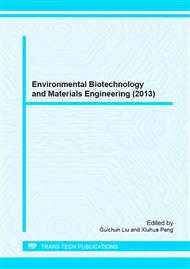p.106
p.112
p.117
p.122
p.127
p.133
p.139
p.143
p.151
Characteristics of Emitted Odor and Discharged Condensate Water of Sludge Thermal Drying Project in Shenzhen Nanshan Thermal Power Plant
Abstract:
During thermal drying of dewatered sludge, odor will be produced, and also plenty of condensate water. Currently, there is little research about odor gas and condensate water produced during thermal drying of dewatered sludge. To supply engineering design basis for treatment scheme of odor and condensate water produced during thermal drying of dewatered sludge, it analyzes pollutants concentration of odor and condensate water produced in Sludge Drying Project in Shenzhen Nanshan Thermal Power Plant, and it verifies removal performance of chemical odor removal system of the Project. It is concluded that during thermal drying of dewatered sludge, odor will be produced, which components are mainly ammonia gas, H2S, CS2, CH3SH and dimethylsulfide, etc.. It is found that organic components in condensate water is high, BOD/COD is about 0.2, NH3-N and TN is high, C/N is about 8, and TP is low.
Info:
Periodical:
Pages:
127-132
Citation:
Online since:
September 2013
Keywords:
Price:
Сopyright:
© 2013 Trans Tech Publications Ltd. All Rights Reserved
Share:
Citation:


